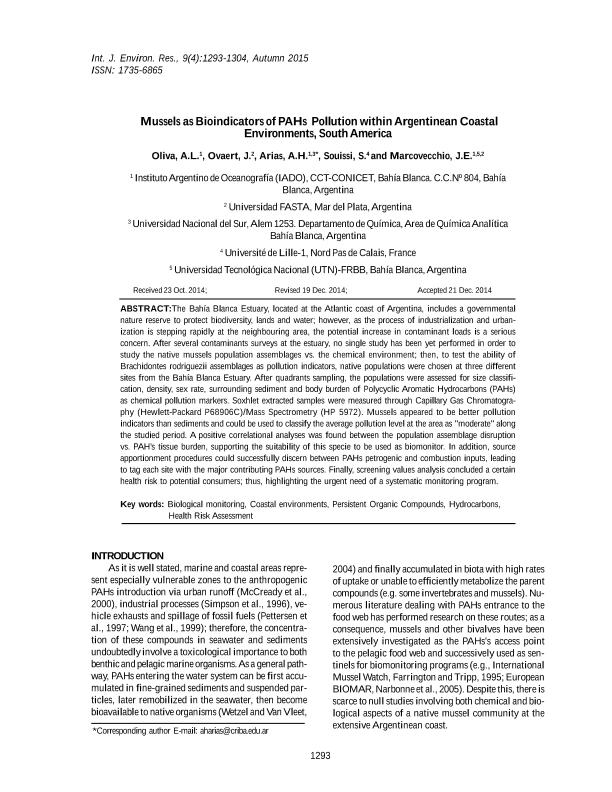Mostrar el registro sencillo del ítem
dc.contributor.author
Oliva, Ana Laura

dc.contributor.author
Ovaert, J.
dc.contributor.author
Arias, Andres Hugo

dc.contributor.author
Souissi, S.
dc.contributor.author
Marcovecchio, Jorge Eduardo

dc.date.available
2017-02-06T21:07:32Z
dc.date.issued
2015-09
dc.identifier.citation
Oliva, Ana Laura; Ovaert, J.; Arias, Andres Hugo; Souissi, S.; Marcovecchio, Jorge Eduardo; Mussels as Bioindicators of PAHs Pollution within Argentinean Coastal Environments, South America; Univ Tehran; International Journal Of Environmental Research; 9; 4; 9-2015; 1293-1304
dc.identifier.issn
1735-6865
dc.identifier.uri
http://hdl.handle.net/11336/12570
dc.description.abstract
The Bahía Blanca Estuary, located at the Atlantic coast of Argentina, includes a governmental nature reserve to protect biodiversity, lands and water; however, as the process of industrialization and urbanization is stepping rapidly at the neighbouring area, the potential increase in contaminant loads is a serious concern. After several contaminants surveys at the estuary, no single study has been yet performed in order to study the native mussels population vs. the chemical environment; then, to test the ability of Brachidontes rodriguezii assemblages as pollution indicators, native populations were chosen at three different sites from the Bahía Blanca Estuary. After quadrants sampling, the populations were assessed for size classification, density, sex rate, surrounding sediment and body burden of Polycyclic Aromatic Hydrocarbons (PAHs) as chemical pollution markers. Soxhlet extracted samples were measured through Capillary Gas Chromatography (Hewlett-Packard P68906C)/Mass Spectrometry (HP 5972). Mussels appeared to be better pollution indicators than sediments and could be used to classify the average pollution level at the area as “moderate” along the studied period. A positive correlational analyses was found between the population assemblage disruption vs. PAH’s tissue burden, supporting the suitability of this specie to be used as biomonitor. In addition, source apportionment procedures could successfully discern between PAHs petrogenic and combustion inputs, leading to tag each site with the major contributing PAHs sources. Finally, screening values analysis concluded a certain health risk to potential consumers; thus, highlighting the urgent need of a systematic monitoring program.
dc.format
application/pdf
dc.language.iso
eng
dc.publisher
Univ Tehran

dc.rights
info:eu-repo/semantics/openAccess
dc.rights.uri
https://creativecommons.org/licenses/by-nc-sa/2.5/ar/
dc.subject
Biological Monitoring
dc.subject
Coastal Enviroments
dc.subject
Persistent Organic Compounds
dc.subject
Hydrocarbons
dc.subject
Health Risk Assessment
dc.subject.classification
Otras Ciencias de la Tierra y relacionadas con el Medio Ambiente

dc.subject.classification
Ciencias de la Tierra y relacionadas con el Medio Ambiente

dc.subject.classification
CIENCIAS NATURALES Y EXACTAS

dc.title
Mussels as Bioindicators of PAHs Pollution within Argentinean Coastal Environments, South America
dc.type
info:eu-repo/semantics/article
dc.type
info:ar-repo/semantics/artículo
dc.type
info:eu-repo/semantics/publishedVersion
dc.date.updated
2017-02-03T17:53:53Z
dc.journal.volume
9
dc.journal.number
4
dc.journal.pagination
1293-1304
dc.journal.pais
Irán

dc.journal.ciudad
Tehran
dc.description.fil
Fil: Oliva, Ana Laura. Consejo Nacional de Investigaciones Científicas y Técnicas. Centro Científico Tecnológico Bahía Blanca. Instituto Argentino de Oceanografía (i); Argentina
dc.description.fil
Fil: Ovaert, J.. Universidad FASTA "Santo Tomas de Aquino"; Argentina
dc.description.fil
Fil: Arias, Andres Hugo. Consejo Nacional de Investigaciones Científicas y Técnicas. Centro Científico Tecnológico Bahía Blanca. Instituto Argentino de Oceanografía (i); Argentina. Universidad Nacional del Sur. Departamento de Quimica. Quimica Analitica; Argentina
dc.description.fil
Fil: Souissi, S.. Université de Lille-1; Francia
dc.description.fil
Fil: Marcovecchio, Jorge Eduardo. Universidad Tecnológica Nacional. Facultad Regional Bahía Blanca; Argentina. Consejo Nacional de Investigaciones Científicas y Técnicas. Centro Científico Tecnológico Bahía Blanca. Instituto Argentino de Oceanografía (i); Argentina. Universidad FASTA "Santo Tomas de Aquino"; Argentina
dc.journal.title
International Journal Of Environmental Research

dc.relation.alternativeid
info:eu-repo/semantics/altIdentifier/url/https://ijer.ut.ac.ir/article_1021.html
Archivos asociados
